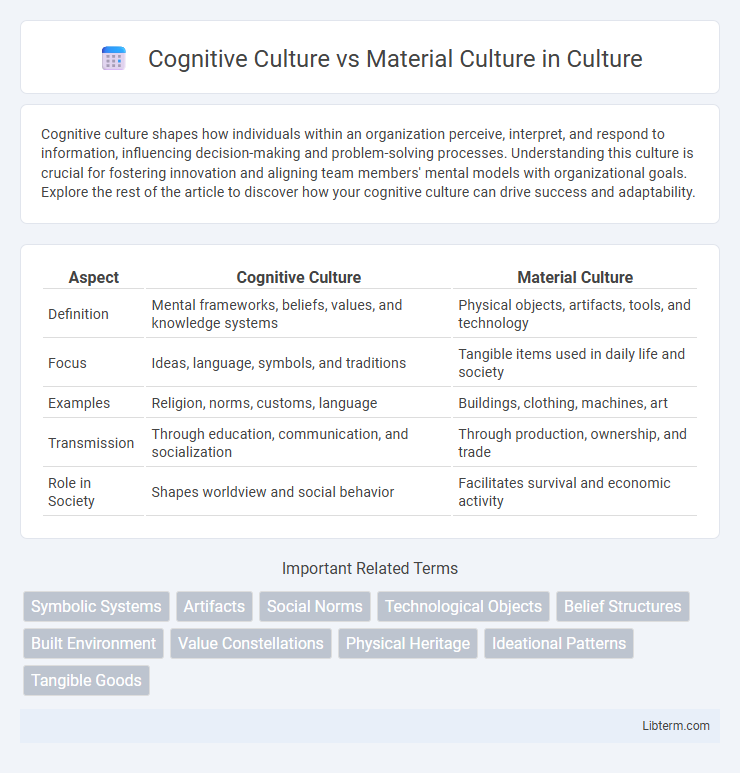Cognitive culture shapes how individuals within an organization perceive, interpret, and respond to information, influencing decision-making and problem-solving processes. Understanding this culture is crucial for fostering innovation and aligning team members' mental models with organizational goals. Explore the rest of the article to discover how your cognitive culture can drive success and adaptability.
Table of Comparison
| Aspect | Cognitive Culture | Material Culture |
|---|---|---|
| Definition | Mental frameworks, beliefs, values, and knowledge systems | Physical objects, artifacts, tools, and technology |
| Focus | Ideas, language, symbols, and traditions | Tangible items used in daily life and society |
| Examples | Religion, norms, customs, language | Buildings, clothing, machines, art |
| Transmission | Through education, communication, and socialization | Through production, ownership, and trade |
| Role in Society | Shapes worldview and social behavior | Facilitates survival and economic activity |
Defining Cognitive Culture
Cognitive culture encompasses the shared beliefs, knowledge systems, values, and thought patterns that shape how a community understands the world and organizes social life. It includes language, symbols, rituals, and collective memories that influence perception and behavior. Unlike material culture, which consists of physical objects and artifacts, cognitive culture is intangible and guides cultural norms and decision-making processes.
Understanding Material Culture
Understanding material culture involves examining physical objects, artifacts, and technological tools created or used by a society, reflecting its values, customs, and social structure. Material culture provides tangible evidence for interpreting historical contexts and human behavior, revealing insights into economic activities, rituals, and daily life. Analyzing material culture complements cognitive culture by linking abstract beliefs and knowledge to the concrete items shaping cultural identity and continuity.
Key Differences Between Cognitive and Material Culture
Cognitive culture encompasses the intangible aspects of culture such as beliefs, values, language, and knowledge systems, while material culture refers to the physical objects, artifacts, and technology created and used by a society. Key differences between cognitive and material culture include their modes of transmission, with cognitive culture primarily passed through social learning and symbolic communication, whereas material culture is transmitted through physical creation and usage of objects. Cognitive culture shapes worldview and social norms, whereas material culture reflects practical adaptations and technological advancements of a community.
The Role of Beliefs and Values in Cognitive Culture
Beliefs and values shape cognitive culture by influencing how individuals interpret information, solve problems, and make decisions within a society. Cognitive culture encompasses shared mental frameworks, norms, and knowledge systems that arise from collective understanding and cultural learning processes. These intangible elements guide behaviors, rituals, and social interactions, distinguishing cognitive culture from material culture, which consists of physical artifacts and tangible objects.
Tangible Artifacts: Hallmarks of Material Culture
Tangible artifacts are the hallmarks of material culture, encompassing physical objects like tools, clothing, and architecture that reflect a society's technological skills and aesthetic values. These artifacts provide concrete evidence of human activity and social organization while serving as vessels of cultural transmission across generations. Cognitive culture, in contrast, involves intangible elements such as beliefs, knowledge, and language that shape the interpretation and significance of these material objects.
Interplay Between Cognitive and Material Culture
Cognitive culture, encompassing beliefs, values, and knowledge, shapes how individuals interpret and interact with their material culture, which includes physical objects, technology, and artifacts. The interplay between these two forms a dynamic feedback loop where material culture influences cognitive frameworks through experience and usage, while cognitive culture drives innovation and modification of material artifacts to meet societal needs. Understanding this relationship is crucial for analyzing cultural evolution and technological advancement in human societies.
Influence on Social Behavior and Identity
Cognitive culture, encompassing shared beliefs, values, and knowledge, shapes social behavior by guiding individuals' perceptions and decision-making processes, directly influencing identity formation through mental frameworks and worldviews. Material culture, consisting of physical objects, artifacts, and technology, affects social behavior by facilitating communication, cooperation, and status display, thereby contributing to identity through tangible expressions of cultural belonging. Both cognitive and material cultures interconnect to define social norms and roles, reinforcing group cohesion and individual self-concept within societal contexts.
Cultural Evolution: Cognitive vs. Material Perspectives
Cognitive culture emphasizes mental processes, beliefs, and knowledge systems that shape human behavior, while material culture focuses on physical artifacts and technological advancements. Cultural evolution in the cognitive perspective highlights the transmission and transformation of ideas, symbols, and language, enabling complex social structures and cooperation. From the material perspective, evolution is driven by changes in tools, infrastructures, and environmental manipulation, reflecting adaptive responses to ecological challenges.
Modern Examples Illustrating Both Cultures
Cognitive culture encompasses beliefs, values, and knowledge systems that shape human thought, exemplified by the rise of digital knowledge-sharing platforms like Wikipedia and scientific communities driving innovation in artificial intelligence. Material culture refers to physical objects and artifacts produced by societies; modern examples include smartphones, smart home devices, and wearable technology, which reflect technological advancement and social lifestyle changes. The interaction between cognitive and material culture is evident in industries such as biotechnology, where scientific understanding (cognitive) informs the development of medical devices and genetic engineering tools (material).
Implications for Cultural Preservation and Change
Cognitive culture, encompassing shared beliefs, values, and knowledge, shapes the intangible aspects vital for cultural preservation, influencing how traditions are interpreted and transmitted over generations. Material culture, consisting of physical artifacts and tangible objects, provides concrete symbols that anchor cultural identity and facilitate the documentation and protection of heritage. The dynamic interplay between cognitive and material culture drives cultural change, as shifts in collective consciousness impact the creation and use of artifacts, while innovations in material culture can reshape social norms and cognitive frameworks.
Cognitive Culture Infographic

 libterm.com
libterm.com